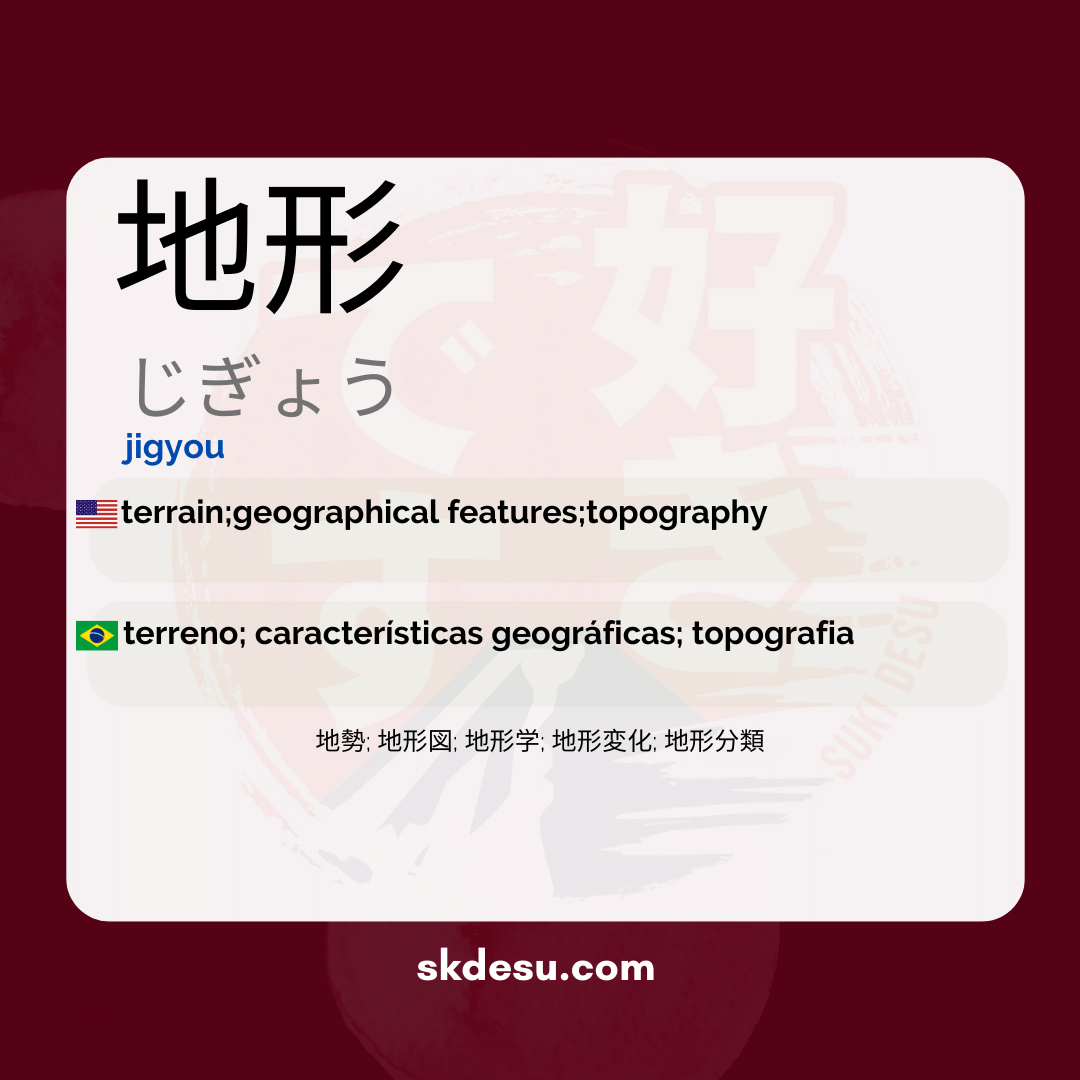Translation and Meaning of: 地形 - jigyou
The Japanese word 地形 (じぎょう, jigyou) may seem simple at first glance, but it carries interesting nuances for those studying the language or interested in Japanese culture. In this article, we will explore its meaning, everyday use, and how it relates to geography and urban planning in the Japanese context. If you've ever wondered how the Japanese describe natural landscapes or terrain features, this is the right place to find out.
In addition to understanding the literal translation of 地形, we will see how this word is applied in different contexts, from informal conversations to technical discussions. If you are looking to memorize the term or simply want to expand your vocabulary in Japanese, this guide from Suki Nihongo will help you master 地形 once and for all.
The meaning and use of 地形 in everyday Japanese.
The term 地形 is composed of two kanji: 地 (chi/ji), meaning "earth" or "ground," and 形 (katachi/kei/gyou), which refers to "shape" or "appearance." Together, they convey the idea of "terrain shape" or "geographical configuration." This word is often used to describe natural features such as mountains, valleys, plains, or any variation on the Earth's surface.
In everyday life, Japanese people use 地形 in various contexts. It can be from a conversation about travel ("The 地形 of this region is very rugged") to discussions about construction ("We need to analyze the 地形 before erecting the building"). Unlike some more technical words, 地形 appears even in informal dialogues, especially in areas with notable geography, such as rural areas or cities surrounded by mountains.
The cultural and practical importance of 地形 in Japan
Japan is a country with an extremely diverse geography – about 73% of the territory is mountainous – which makes 地形 a concept deeply rooted in the local culture. From traditional agriculture to city design, understanding the terrain has always been vital for the survival and development of Japanese society.
This is reflected even in the language. While in Portuguese we use generic terms like "landform," Japanese uses 地形 to specify the physical configuration of the terrain. This linguistic precision shows how the relationship with the land is a fundamental part of Japanese identity, influencing everything from architecture to local mythology.
Tips for memorizing and using 地形 correctly
An effective way to memorize 地形 is to associate its component kanjis with concrete images. Visualize 地 as the ground beneath your feet and 形 as the outline of a mountain on the horizon. This mental association helps remember that the word refers to the shape of the terrain. Another tip is to practice with real examples: when looking at photos of Japanese landscapes, try to describe them using 地形 in simple sentences.
It's worth remembering that, although 地形 is a versatile term, it is more commonly used for objective descriptions rather than poetic expressions. If you are writing a haiku or want to sound more literary, there are other more suitable words. But for everyday conversations and informational texts, 地形 is the perfect choice to talk about the shape of the land.
Vocabulary
Expand your vocabulary with related words:
Synonyms and similar words
- 地勢 (Chisei) - Characteristics of the land, such as relief and slopes.
- 地形図 (Chikeizu) - Topographic map that represents the physical characteristics of the Earth's surface.
- 地形学 (Chikeigaku) - Study of the forms and characteristics of the Earth's relief.
- 地形変化 (Chikeihenka) - Changes in the forms and characteristics of the relief over time.
- 地形分類 (Chikeibunrui) - Classification of the different landforms based on their characteristics.
Romaji: jigyou
Kana: じぎょう
Type: noun
L: jlpt-n1
Translation / Meaning: ground; geographical characteristics; topography
Meaning in English: terrain;geographical features;topography
Definition: The shape and arrangement of the Earth's surface.
Quick Access
- Vocabulary
- Writing
- Sentences
How to Write in Japanese - (地形) jigyou
See below a step-by-step guide on how to write the word by hand in Japanese. (地形) jigyou:
Example Sentences - (地形) jigyou
See below some example sentences:
Chikei ga kewashii yamamichi wo noboru no wa taihen da
Climbing a mountain trail with rugged terrain is difficult.
It is difficult to climb a steep mountain path.
- 地形 (chikei) - ground
- が (ga) - subject particle
- 険しい (kewashii) - steep, difficult
- 山道 (yamamichi) - mountain trail
- を (wo) - direct object particle
- 登る (noboru) - climb
- のは (no wa) - particle that indicates topic
- 大変 (taihen) - Difficult, laborious
- だ (da) - Verb "to be"
Other Words of this Type: noun
See other words from our dictionary that are also: noun

